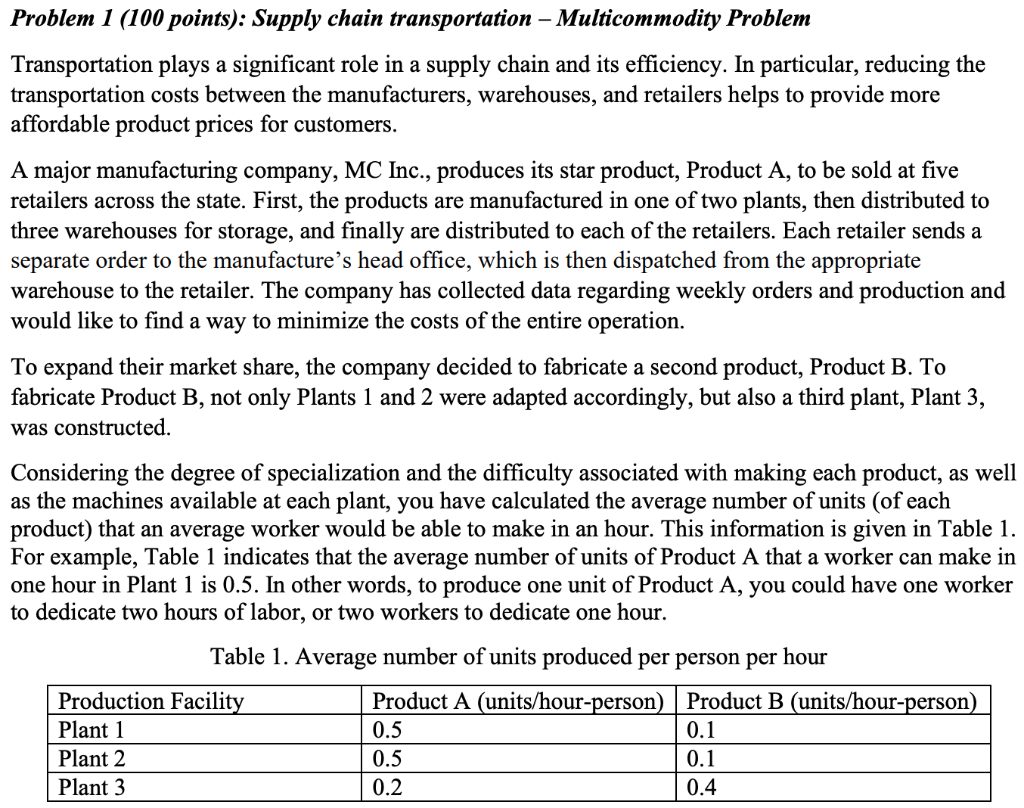
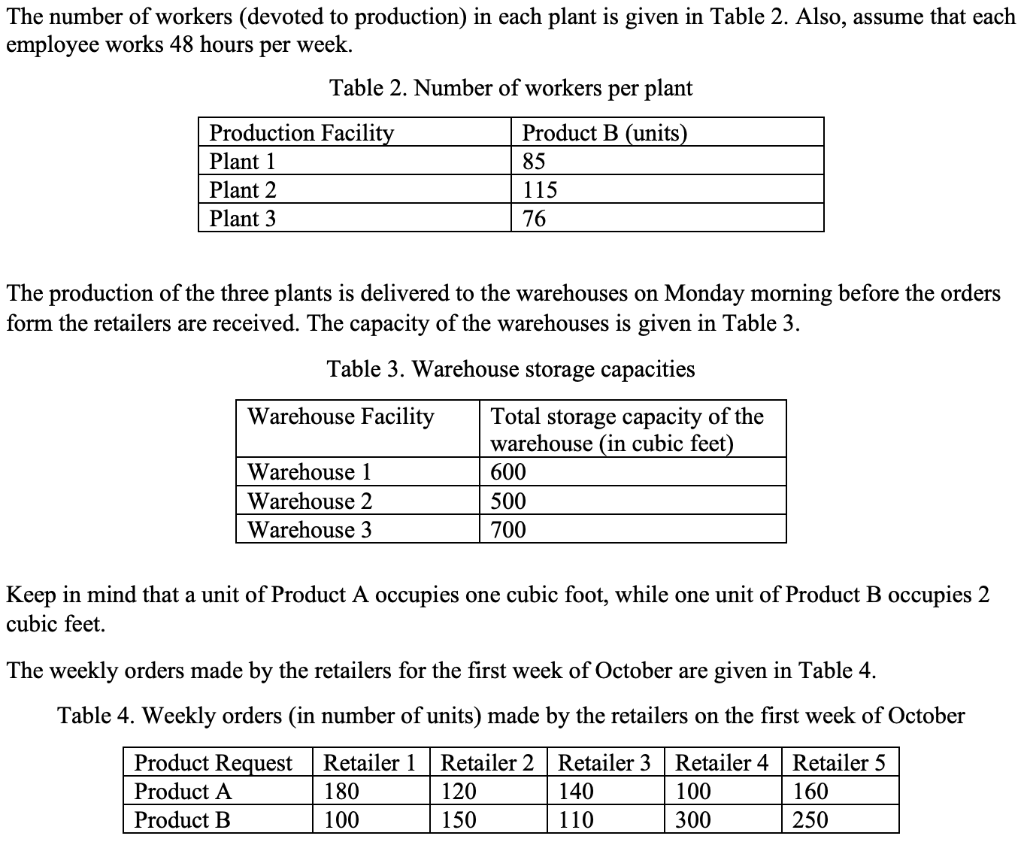

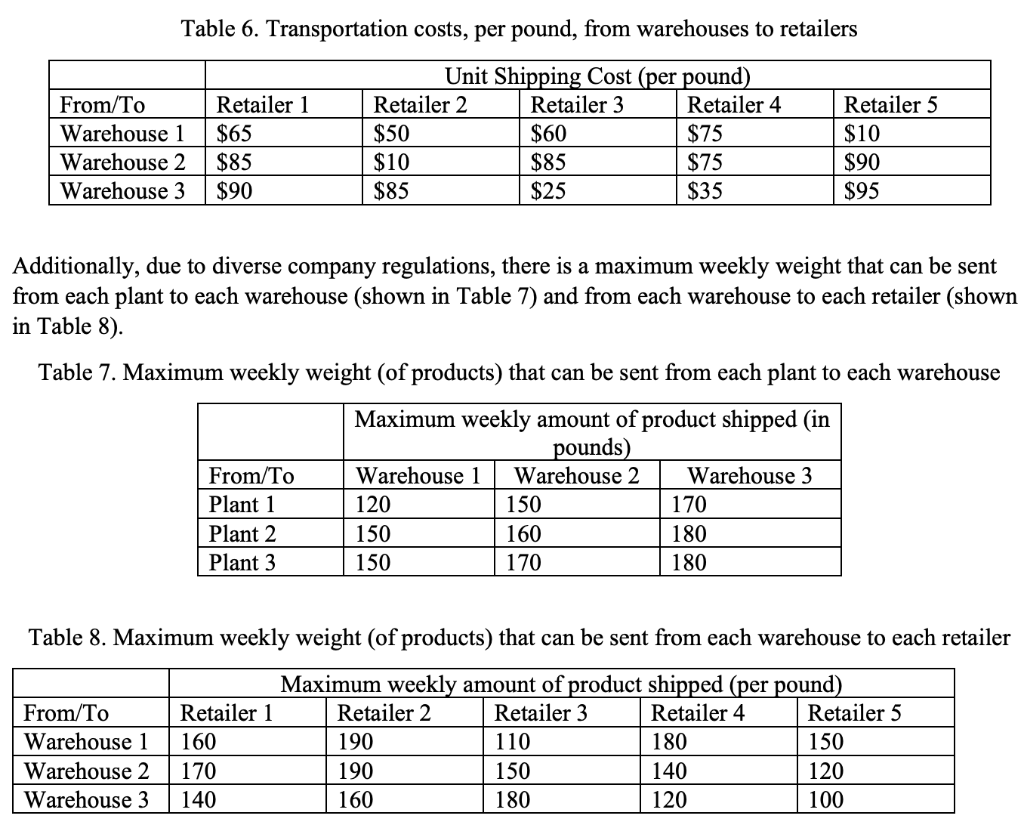
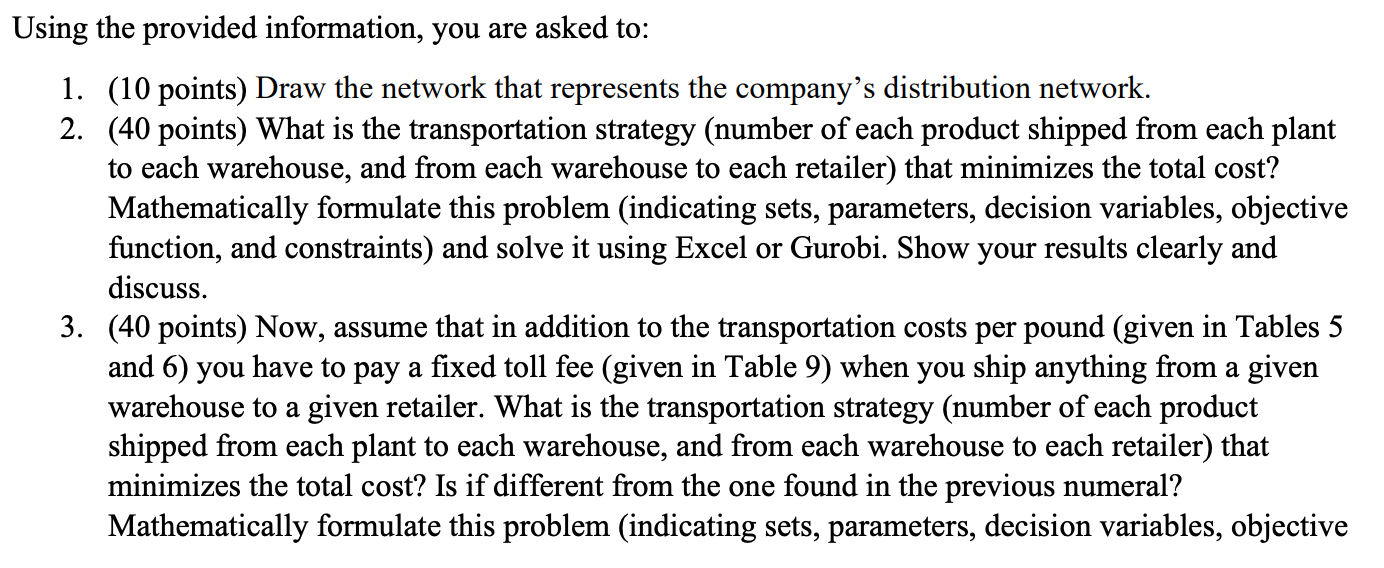
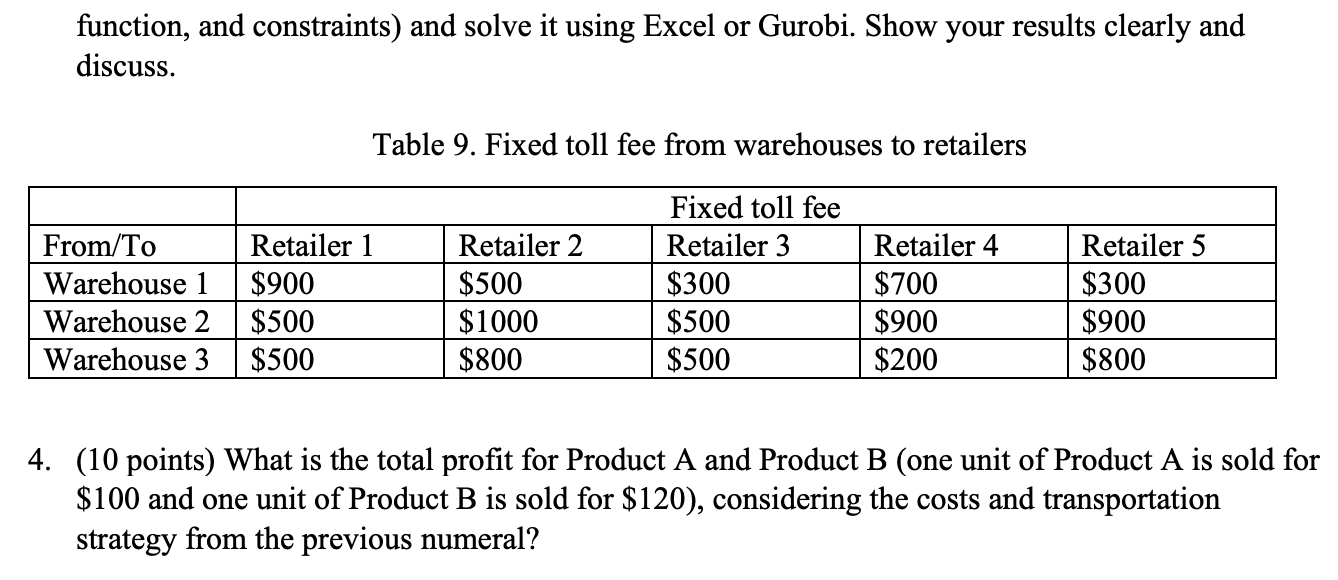
Problem 1 (100 points): Supply chain transportation - Multicommodity Problem Transportation plays a significant role in a supply chain and its efficiency. In particular, reducing the transportation costs between the manufacturers, warehouses, and retailers helps to provide more affordable product prices for customers. A major manufacturing company, MC Inc., produces its star product, Product A, to be sold at five retailers across the state. First, the products three warehouses for storage, and finally are distributed to each of the retailers. Each retailer sends a separate order to the manufacture's head office, which is then dispatched from the appropriate warehouse to the retailer. The company has collected data regarding weekly orders and production and would like to find a way to minimize the costs of the entire operation. are manufactured in one of two plants, then distributed to To expand their market share, the company decided to fabricate a second product, Product B. To fabricate Product B, not only Plants 1 and 2 were was constructed adapted accordingly, but also a third plant, Plant 3, Considering the degree of specialization and the difficulty associated with making each product, as well as the machines available at each plant, you have calculated the average number of units (of each product) that an average worker would be able to make in an hour. This information is given in Table 1. For example, Table 1 indicates that the average number of units of Product A that a worker can make in one hour in Plant 1 is 0.5. In other words, to produce one unit of Product A, you could have one worker to dedicate two hours of labor, or two workers to dedicate one hour. Table 1. Average number of units produced per person per hour Production Facility Product A (units/hour-person) Product B (units/hour-person) 0.5 Plant 1 0.1 Plant 2 0.5 0.1 Plant 3 0.2 0.4 The number of workers (devoted to production) in each plant is given in Table 2. Also, assume that each employee works 48 hours per week. Table 2. Number of workers per plant Production Facility Product B (units) Plant1 85 Plant 2 115 Plant 3 76 Monday morning before the orders The production of the three plants is delivered to the warehouses on form the retailers are received. The capacity of the warehouses is given in Table 3. Table 3. Warehouse storage capacities Warehouse Facility Total storage capacity of the warehouse (in cubic feet) Warehouse 1 600 Warehouse 2 500 Warehouse 3 700 Keep in mind that a unit of Product A occupies cubic feet one cubic foot, while one unit of Product B occupies 2 given in Table 4 The weekly orders made by the retailers for the first week of October are Table 4. Weekly orders (in number of units) made by the retailers on the first week of October Product Request Retailer 2 Retailer 3 Retailer 1 Retailer 4 Retailer 5 Product A 180 120 140 100 160 100 Product B 150 110 300 250 given pound, while The transportation costs (per pound) from the plants to warehouses and warehouses to retailers are in Table 5 and Table 6, respectively. Keep in mind that one unit of Product 1 weights one unit of Product B weights 3 pounds. one Table 5. Transportation costs, per pound, from production plants to warehouses Unit Shipping cost (per pound) From/To Warehouse 1 Warehouse 2 Warehouse 3 Plant 1 $20 $80 $30 $30 $25 $95 $45 $50 $50 Plant 2 Plant 3 Table 6. Transportation costs, per pound, from warehouses to retailers Unit Shipping Cost (per pound) From/To Retailer 1 Retailer 2 Retailer 3 Retailer 5 Retailer 4 Warehouse 1 $65 $50 $60 $75 $10 $85 $90 $10 $85 $85 $25 Warehouse 2 $75 $90 $95 Warehouse 3 $35 Additionally, due to diverse company regulations, there is a maximum weekly weight that can be sent from each plant to each warehouse (shown in Table 7) and from each warehouse to each retailer (shown in Table 8) Table 7. Maximum weekly weight (of products) that can be sent from each plant to each warehouse Maximum weekly amount of product shipped (in pounds) Warehouse 2 From/To Warehouse 1 Warehouse 3 Plant 170 120 150 Plant 2 150 160 180 Plant 3 150 170 180 Table 8. Maximum weekly weight (of products) that can be sent from each warehouse to each retailer Maximum weekly amount of product shipped (per pound) Retailer 3 From/To Retailer 4 Retailer 1 Retailer 2 Retailer 5 Warehouse 1 160 190 110 180 150 Warehouse 2 170 190 150 140 120 Warehouse 3 140 160 180 120 100 Using the provided information, you are asked to: 1. (10 points) Draw the network that represents the company's distribution network. 2. (40 points) What is the transportation strategy (number of each product shipped from each plant to each warehouse, and from each warehouse to each retailer) that minimizes the total cost? Mathematically formulate this problem (indicating sets, parameters, decision variables, objective function, and constraints) and solve it using Excel or Gurobi. Show your results clearly and discuss 3. (40 points) Now, assume that in addition to the transportation costs per pound (given in Tables 5 and 6) you have to pay a fixed toll fee (given in Table 9) when you ship anything from a given warehouse to a given retailer. What is the transportation strategy (number of each product shipped from each plant to each warehouse, and from each warehouse to each retailer) that minimizes the total cost? Is if different from the one found in the previous numeral? Mathematically formulate this problem (indicating sets, parameters, decision variables, objective function, and constraints) and solve it using Excel or Gurobi. Show your results clearly and discuss Table 9. Fixed toll fee from warehouses to retailers Fixed toll fee From/To Retailer 1 Retailer 2 Retailer 3 Retailer 5 Retailer 4 $500 $1000 $300 $500 $500 $300 $900 Warehouse 1 $900 $700 $900 $200 Warehouse 2 $500 $500 Warehouse 3 $800 $800 (10 points) What is the total profit for Product A and Product B (one unit of Product A is sold for $100 and one unit of Product B is sold for $120), considering the costs and transportation strategy from the previous numeral? 4. Problem 1 (100 points): Supply chain transportation - Multicommodity Problem Transportation plays a significant role in a supply chain and its efficiency. In particular, reducing the transportation costs between the manufacturers, warehouses, and retailers helps to provide more affordable product prices for customers. A major manufacturing company, MC Inc., produces its star product, Product A, to be sold at five retailers across the state. First, the products three warehouses for storage, and finally are distributed to each of the retailers. Each retailer sends a separate order to the manufacture's head office, which is then dispatched from the appropriate warehouse to the retailer. The company has collected data regarding weekly orders and production and would like to find a way to minimize the costs of the entire operation. are manufactured in one of two plants, then distributed to To expand their market share, the company decided to fabricate a second product, Product B. To fabricate Product B, not only Plants 1 and 2 were was constructed adapted accordingly, but also a third plant, Plant 3, Considering the degree of specialization and the difficulty associated with making each product, as well as the machines available at each plant, you have calculated the average number of units (of each product) that an average worker would be able to make in an hour. This information is given in Table 1. For example, Table 1 indicates that the average number of units of Product A that a worker can make in one hour in Plant 1 is 0.5. In other words, to produce one unit of Product A, you could have one worker to dedicate two hours of labor, or two workers to dedicate one hour. Table 1. Average number of units produced per person per hour Production Facility Product A (units/hour-person) Product B (units/hour-person) 0.5 Plant 1 0.1 Plant 2 0.5 0.1 Plant 3 0.2 0.4 The number of workers (devoted to production) in each plant is given in Table 2. Also, assume that each employee works 48 hours per week. Table 2. Number of workers per plant Production Facility Product B (units) Plant1 85 Plant 2 115 Plant 3 76 Monday morning before the orders The production of the three plants is delivered to the warehouses on form the retailers are received. The capacity of the warehouses is given in Table 3. Table 3. Warehouse storage capacities Warehouse Facility Total storage capacity of the warehouse (in cubic feet) Warehouse 1 600 Warehouse 2 500 Warehouse 3 700 Keep in mind that a unit of Product A occupies cubic feet one cubic foot, while one unit of Product B occupies 2 given in Table 4 The weekly orders made by the retailers for the first week of October are Table 4. Weekly orders (in number of units) made by the retailers on the first week of October Product Request Retailer 2 Retailer 3 Retailer 1 Retailer 4 Retailer 5 Product A 180 120 140 100 160 100 Product B 150 110 300 250 given pound, while The transportation costs (per pound) from the plants to warehouses and warehouses to retailers are in Table 5 and Table 6, respectively. Keep in mind that one unit of Product 1 weights one unit of Product B weights 3 pounds. one Table 5. Transportation costs, per pound, from production plants to warehouses Unit Shipping cost (per pound) From/To Warehouse 1 Warehouse 2 Warehouse 3 Plant 1 $20 $80 $30 $30 $25 $95 $45 $50 $50 Plant 2 Plant 3 Table 6. Transportation costs, per pound, from warehouses to retailers Unit Shipping Cost (per pound) From/To Retailer 1 Retailer 2 Retailer 3 Retailer 5 Retailer 4 Warehouse 1 $65 $50 $60 $75 $10 $85 $90 $10 $85 $85 $25 Warehouse 2 $75 $90 $95 Warehouse 3 $35 Additionally, due to diverse company regulations, there is a maximum weekly weight that can be sent from each plant to each warehouse (shown in Table 7) and from each warehouse to each retailer (shown in Table 8) Table 7. Maximum weekly weight (of products) that can be sent from each plant to each warehouse Maximum weekly amount of product shipped (in pounds) Warehouse 2 From/To Warehouse 1 Warehouse 3 Plant 170 120 150 Plant 2 150 160 180 Plant 3 150 170 180 Table 8. Maximum weekly weight (of products) that can be sent from each warehouse to each retailer Maximum weekly amount of product shipped (per pound) Retailer 3 From/To Retailer 4 Retailer 1 Retailer 2 Retailer 5 Warehouse 1 160 190 110 180 150 Warehouse 2 170 190 150 140 120 Warehouse 3 140 160 180 120 100 Using the provided information, you are asked to: 1. (10 points) Draw the network that represents the company's distribution network. 2. (40 points) What is the transportation strategy (number of each product shipped from each plant to each warehouse, and from each warehouse to each retailer) that minimizes the total cost? Mathematically formulate this problem (indicating sets, parameters, decision variables, objective function, and constraints) and solve it using Excel or Gurobi. Show your results clearly and discuss 3. (40 points) Now, assume that in addition to the transportation costs per pound (given in Tables 5 and 6) you have to pay a fixed toll fee (given in Table 9) when you ship anything from a given warehouse to a given retailer. What is the transportation strategy (number of each product shipped from each plant to each warehouse, and from each warehouse to each retailer) that minimizes the total cost? Is if different from the one found in the previous numeral? Mathematically formulate this problem (indicating sets, parameters, decision variables, objective function, and constraints) and solve it using Excel or Gurobi. Show your results clearly and discuss Table 9. Fixed toll fee from warehouses to retailers Fixed toll fee From/To Retailer 1 Retailer 2 Retailer 3 Retailer 5 Retailer 4 $500 $1000 $300 $500 $500 $300 $900 Warehouse 1 $900 $700 $900 $200 Warehouse 2 $500 $500 Warehouse 3 $800 $800 (10 points) What is the total profit for Product A and Product B (one unit of Product A is sold for $100 and one unit of Product B is sold for $120), considering the costs and transportation strategy from the previous numeral? 4












